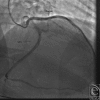CASE REPORT Anomalies Associated With Congenitally Corrected Transposition of Great Arteries: Expect the Unexpected
- PMID: 23409204
- PMCID: PMC3556635
CASE REPORT Anomalies Associated With Congenitally Corrected Transposition of Great Arteries: Expect the Unexpected
Abstract
Objective: Congenitally corrected transposition of great arteries (CCTGA) is characterized by atrioventricular and ventriculoarterial discordance. Characterizations of these anomalies are important because they may influence surgical approach and management.
Methods: We present a case of newly diagnosed CCTGA at the age of 50. He presented with sudden onset of shortness of breath for the first time and was diagnosed with CCTGA. Echocardiogram, magnetic resonance imaging, and cardiac catheterization were utilized to elucidate the pathology.
Results: Intraoperatively, patient's CCTGA and ventricularization of the right ventricle were confirmed. The severe systemic atrioventricular valve regurgitation was replaced with a bioprosthetic valve (Medtronic Mosaic No. 29) with placement of epicardial ventricular leads for possible future placement of automatic implantable cardioverter defibrillators. Pathology report confirmed a degeneration of the systemic atrioventricular valve.
Conclusions: Significant coronary artery anomalies have also been described in literature with CCTGA. The variances encountered in this case are excellent examples of the intricacies associated in diagnosis and surgical care in patients with CCTGA.
Figures









Similar articles
-
Congenitally corrected transposition of the great arteries and coronary artery disease: a case report in an 83-year-old male.Eur Heart J Case Rep. 2025 May 7;9(5):ytaf161. doi: 10.1093/ehjcr/ytaf161. eCollection 2025 May. Eur Heart J Case Rep. 2025. PMID: 40336940 Free PMC article.
-
Acute myocardial infarction in a patient with congenitally corrected transposition of the great arteries and complex coronary anatomy-a case report.Eur Heart J Case Rep. 2022 Nov 2;6(11):ytac423. doi: 10.1093/ehjcr/ytac423. eCollection 2022 Nov. Eur Heart J Case Rep. 2022. PMID: 36405539 Free PMC article.
-
Asymptomatic Isolated Congenitally Corrected Transposition of the Great Arteries in a 25-Year-Old Male: A Case Report.J Investig Med High Impact Case Rep. 2025 Jan-Dec;13:23247096251331840. doi: 10.1177/23247096251331840. Epub 2025 May 8. J Investig Med High Impact Case Rep. 2025. PMID: 40340415 Free PMC article.
-
Management of congenitally corrected transposition from fetal diagnosis to adulthood.Expert Rev Cardiovasc Ther. 2023 Jun;21(6):389-396. doi: 10.1080/14779072.2023.2211264. Epub 2023 May 9. Expert Rev Cardiovasc Ther. 2023. PMID: 37143366 Review.
-
Technical aspects of the combined arterial switch and senning operation for congenitally corrected transposition of the great arteries.Semin Thorac Cardiovasc Surg Pediatr Card Surg Annu. 2003;6:9-15. doi: 10.1053/pcsu.2003.50011. Semin Thorac Cardiovasc Surg Pediatr Card Surg Annu. 2003. PMID: 12740767 Review.
Cited by
-
Congenitally corrected transposition of the great arteries and coronary artery disease: a case report in an 83-year-old male.Eur Heart J Case Rep. 2025 May 7;9(5):ytaf161. doi: 10.1093/ehjcr/ytaf161. eCollection 2025 May. Eur Heart J Case Rep. 2025. PMID: 40336940 Free PMC article.
-
Acute myocardial infarction in a patient with congenitally corrected transposition of the great arteries and complex coronary anatomy-a case report.Eur Heart J Case Rep. 2022 Nov 2;6(11):ytac423. doi: 10.1093/ehjcr/ytac423. eCollection 2022 Nov. Eur Heart J Case Rep. 2022. PMID: 36405539 Free PMC article.
References
-
- Ferencz C, Rubin JD, McCarter RJ, et al. Congenital heart disease: Prevalence at livebirth. Am J Epidemiol. 1985;121:31–6. - PubMed
-
- Perloff JK. Congenitally corrected transposition of the great arteries. In: Perloff JK, editor. Clinical Recognition of Congenital Heart Disease. 4th ed. Philadelphia: W. B. Saunders; 1994. pp. 62–80.
-
- Mullins CE, Mayer DC, editors. Congenital Heart Disease: A Diagrammatic Atlas. New York, NY: Wiley-Liss; 1988. p. 223.
-
- Hoppe UC, Dederichs B, Deutsch HJ, et al. Congenital heart disease in adults and adolescents: comparative value of transthoracic echocardiography and MR imaging. Radiology. 1996;199:669–77. - PubMed
-
- Neufeld HN, Schneeweiss A. Coronary Artery Disease in Infants and Children. 1st ed. Philadelphia, PA: Lee and Febiger; 1983. p. 91.
LinkOut - more resources
Full Text Sources
